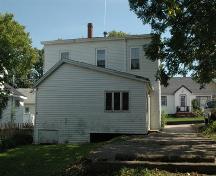37 St. James Street
37 St. James Street, Annapolis Royal, Nova Scotia, B0S 1A0, Canada
Formally Recognized: 1982/05/21
Other Name(s)
N/A
Links and Documents
Listed on the Canadian Register: 2007/12/07
Statement of Significance
Description of Historic Place
37 St. James Street consists of a two storey building located adjacent to the road and built in the Neo-Classical style, and a small residential lot. The house is located in a residential area and is in close proximity to other heritage properties. Both the house and the property are included in the municipal heritage designation.Heritage Value
The property at 37 St. James Street, as recognized by its municipal heritage designation, is valued for its contribution to the architectural landscape of the town and its association with historic local personalities.Historic Value:
The lot was originally part of a larger property owned in the seventeenth century by the Acadian Petitpas family. It passed to Christophe Cahouet, an innkeeper and merchant from France. Following the 1710 British conquest of Nova Scotia, Cahoet returned to France and the property eventually passed to Cahouet’s brother-in-law, British officer William Winniett. Winniett and Cahouet each married a daughter of French privateer Captain Pierre Maisonnat dit Baptiste.
By the turn of the nineteenth century, the property had passed to Thomas Williams Jr. a descendant of William Winniett. His father, Thomas Williams has built a home on the property sometime in the early eighteenth century. Williams Jr. served as commissary of provisions for the Annapolis Royal garrison and was father of the future General Sir William Fenwick Williams, who was born to Williams and his wife Maria Walker. Sir Williams had a distinguished career. He was decorated for his actions in the Crimean War; commander-in-chief of forces in British North America from 1860 until 1865; Nova Scotia's first native-born Lieutenant-Governor from 1865 until 1867; and served as governor of Gibraltar from 1870 until 1876.
In 1846 the property was sold to Joseph Norman, who was the last ordnance storekeeper at Fort Anne. Norman resided in the old Williams home with his wife Gregoria Ramona Antonia Reiez. Reiez, who was born in Spain, had reportedly been a vivandiere with the British expeditionary forces in Europe during the Napoleonic Wars and, by her own account, a favourite of the Duke of Wellington.
Circa 1874, the original Williams house was broken into three sections and removed from to make way for the construction of the Union Bank of Halifax building; now the Royal Bank of Canada, and the property was subdivided. In 1875 merchant Harris VanBlarcom purchased lots no. 2 and no. 3 of the Norman property and reportedly moved a portion of the early Williams house onto his lots. The two other pieces of the original Williams house exist as buildings on St. Anthony and Chapel Streets. 37 St. James Street was created in 1905 when the property was again subdivided. In 1924 the house was bought by railway employee, Charles A. Ritchie, and was owned by members of his family until 1998.
Architectural Value:
The most important architectural assets of this house are the pieces of the early Williams house which are presently hidden under modern alterations. The front portico, which is topped with a pediment, is the main decoration for the exterior of the house. Strangely, the chimney for this house is offset and breaks from the Neo-Classical standard of complete symmetry. The building has a one storey ell that has an asymmetrical gable roof. While the current configuration of the house would not date prior to 1875, parts of the structure are significantly older than this date.
Source: Heritage Property Files, Annapolis Heritage Society
Character-defining Elements
The character-defining elements of 37 St James Street relate to its Neo-classical style and include:-two storey size and single detached massing;
- front entry portico supported by two columns surmounted by a pediment;
- overall symmetry of the front facade;
- low gable roof.
Other character-defining elements of 37 St. James Street include:
- all original eighteenth century elements, including framing;
- double hung, wooden sash windows;
- small window openings in contrast to the scale of the building;
- front windows grouped close to the centre of the building;
Recognition
Jurisdiction
Nova Scotia
Recognition Authority
Local Governments (NS)
Recognition Statute
Heritage Property Act
Recognition Type
Municipally Registered Property
Recognition Date
1982/05/21
Historical Information
Significant Date(s)
N/A
Theme - Category and Type
Peopling the Land
Settlement
Function - Category and Type
Current
Residence
Single Dwelling
Architect / Designer
N/A
Builder
N/A
Additional Information
Location of Supporting Documentation
Annapolis Heritage Society, 136 St George Street, Annapolis Royal, Nova Scotia.
FED/PROV/TERR Identifier
02MNS0172










